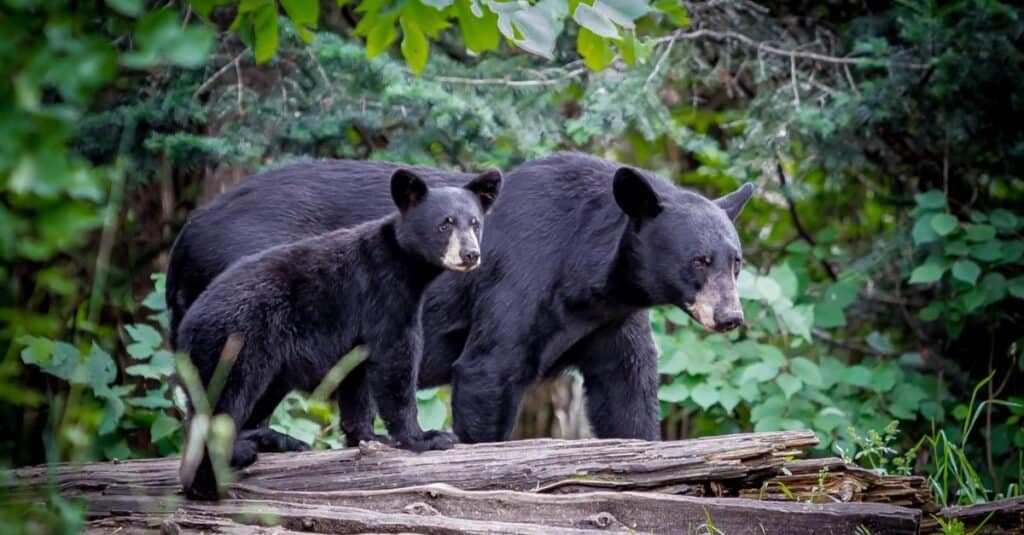
Black bears are abundant in Michigan.
©jo Crebbin/Shutterstock.com
The Ursus americanus, or black bear, is the only bear species in Michigan. The bears in Michigan are increasing in numbers and reportedly moving further south. The upper Penisula has the most significant population of black bears. Authorities say that 10,560 or more bears live in this area. However, the population on the lower peninsula is rapidly growing.
One hundred years ago, black bears were all part of the state, but humans moved in, harvested many animals, and pushed the remaining bears toward the upper peninsula. Hunting for bears is regulated by the Michigan Department of Natural Resources (DNR).
In the history of Michigan, there have been several bear attacks. However, there have only been three fatalities due to an encounter with a bear. Areas of this state are teeming with bears, but the animals are not malicious and are more likely to try to avoid you than to attack you.
1) Baraga County in the Upper Peninsula
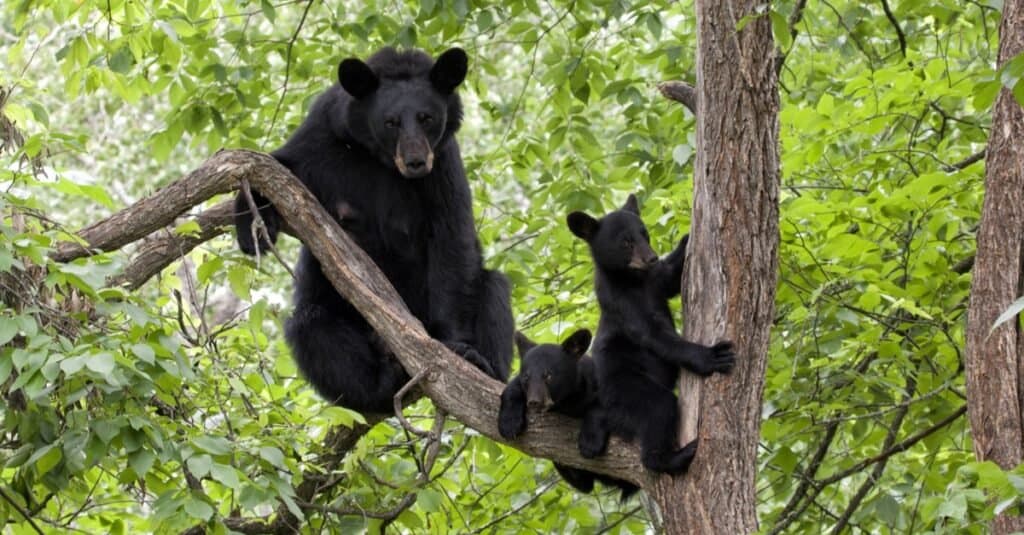
Momma bears are aggressive about defending their cubs.
©Debbie Steinhausser/Shutterstock.com
On the shores of Lake Superior sits a village located on L’Anse Bay. Baraga is an ideal location for a black bear sighting. The proximity to the lake and bays provides the bears with ample fish and marine animals. The forests in the area provide natural resources and areas where the bears can make their dens.
The rural, wooded area of Baraga County is bear heaven. The male bears wander three to four miles from their winter dens. The females stay between two and three miles from their den. Juvenile bears forced away from their mothers wander up to a hundred miles looking for a habitat to call home.
Baraga County is an excellent place to see lots of bears in Michigan. Any place that offers good hiking, fishing, and places to enjoy outdoor activities is a good place to see bears.
2) Battle Creek In West Central Michigan
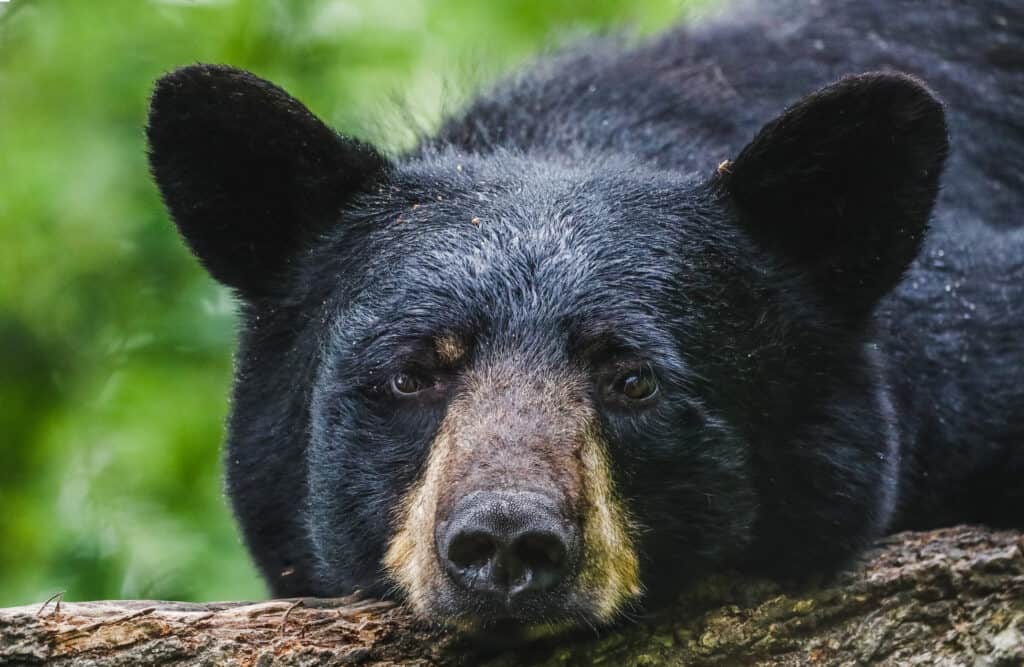
Never intentionally feed a bear.
©iStock.com/Mandy Fuller Photography
A police officer shot and killed a black bear in Battle Creek in 2008. The bear is currently housed in the Kingsman Museum after being preserved by a nearby taxidermist. West central Michigan is home to Battle Creek, with increasingly more reports of bear sightings.
This portion of Michigan is a prime habitat for black bears. There is ample food and shelter to support the animals. There will be increased sightings of the animals as their population grows. If you encounter a bear, do not run. Do not climb a tree or try to hide. Instead, make yourself look as big as possible by spreading your arms wide. Make as much noise as you can. Do not act frightened. Do give the bear room to escape.
These bears are merely going about their daily lives. They are not typically aggressive. They want to be left alone. However, a mother bear with cubs can be a dangerous animal
3) Cadillac In The Lower Peninsula
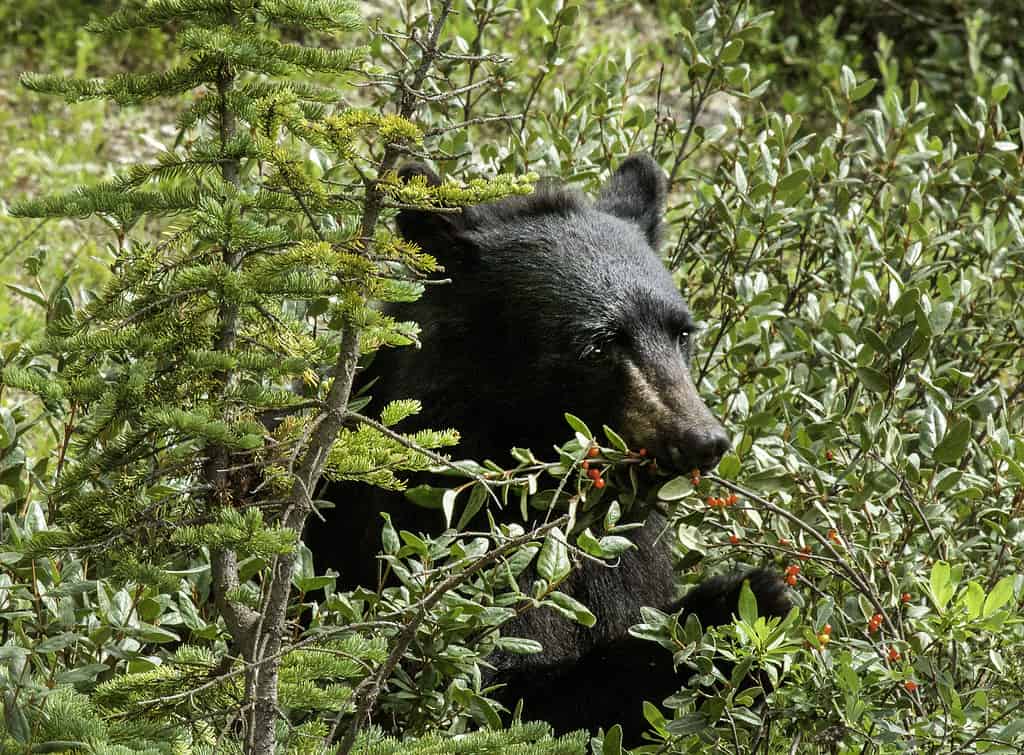
Bears live in forests with plenty of berries and natural resources available.
©millermountainman/ via Getty Images
The city of Cadillac is the county seat of Wexford County. Although Cadillac is on the lower peninsula of Michigan, with population growth, increasing sightings of black bears are occurring. Why are more black bears moving toward Cadillac?
- First, a study in 1990 by the Michigan Department of Natural Resources and the US Forest Service revealed that the area around Cadillac offers fabulous bear habitat.
- Secondly, the upper peninsula has an increased population of bears, so the bears are moving south to find food and shelter.
- Third, the natural resources in the area offer ample food for hungry bears.
4) Detroit In The Lower Peninsula
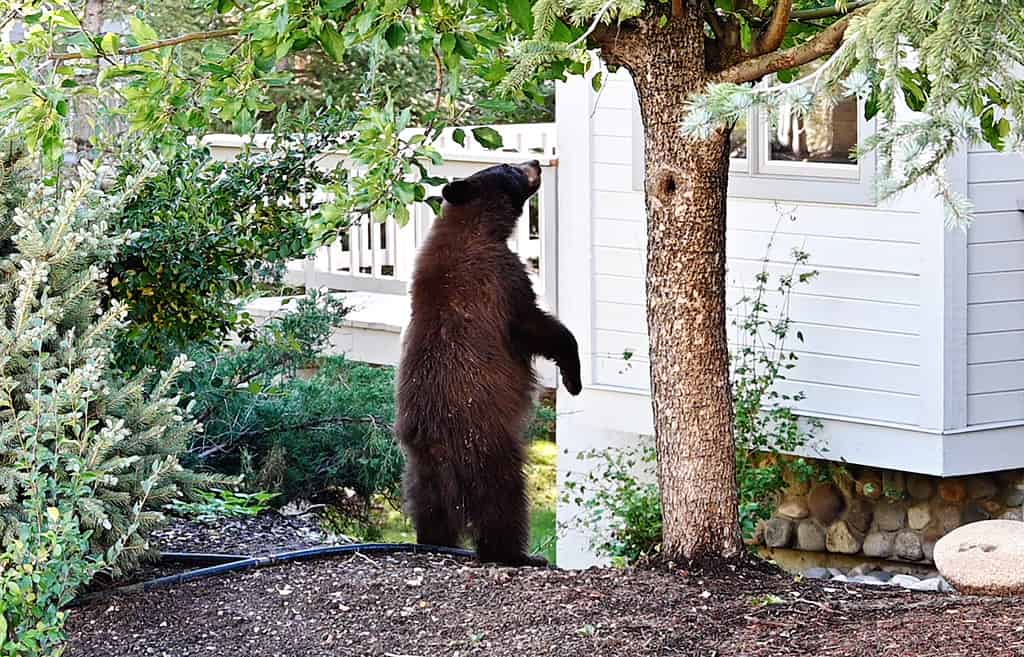
Bears feed on human foods found in garbage around our homes.
©steverts/iStock via Getty Images
A 12-year-old girl had a horrifying encounter with a black bear on her grandfather’s property in Detroit, Michigan. The girl was running behind her cabin on August 16, 2013, when the bear attack happened. The unprovoked attack left the girl with several cuts, bruises, and puncture wounds. Bear attacks occur in Michigan. However, the instances are rare.
Bear populations are increasing, and bears are attracted to human food odors. More bears will be found breaking into homes, ruffling through trash, and hanging around areas where they can find pet food or an easy meal.
5) Grand Island and The Hiawatha National Park
The upper peninsula of Michigan has the most bears. Hiawatha National Forest. The forest is teeming with black bears. The area of Grand Isle has breathtaking views, inland lakes, opportunities for outdoor activities like camping and hiking, and bears.
Authorities warn against feeding the bears. The Grand Isle is an eight-mile stretch of land. However, in 2014, the bear population there was 20. The number does not sound high unless you consider that 20 bears in an eight-mile area mean more possible human-to-bear encounters.
Wildlife biologists of the Hiawatha National Forest advise:
- Keep camping areas clean of food and waste.
- Store food in airtight containers.
- Do not leave a cooler or lunchbox unattended.
- Wash cooking utensils quickly after you use them.
- Never sleep in clothing that has blood on it.
- Change clothing after cooking before you retire for the night.
- Store trash in an airtight container. Do not burn trash. Do not bury trash.
- Utilize the bear-proof lockers on Grand Isle to store food, sunscreen, and other scented items that will attract bears.
- Store toiletries in airtight containers in your locked vehicle or a locker.
- Carry bear spray.
6) Ionia County In The Lower Peninsula

When the bear population increases, so do the bear encounters.
©Pawel Serafin/Shutterstock.com
The county of Ionia is located in the west-central portion of the lower peninsula, quickly becoming a hot spot for black bear sightings. Black bears are moving southward to find new habitats. A young black bear male gets pushed out during mating season, and when this happens, the bear looks for a new place to call home.
Ionia County is home to forests, beekeepers, and perfect bear attractants. With the males, there will be females and the inevitable babies. The lower peninsula of Michigan has a current bear population of about 3,000. However, with more bears moving south, the population will continue to grow.
7) Ontonagon In The Upper Peninsula
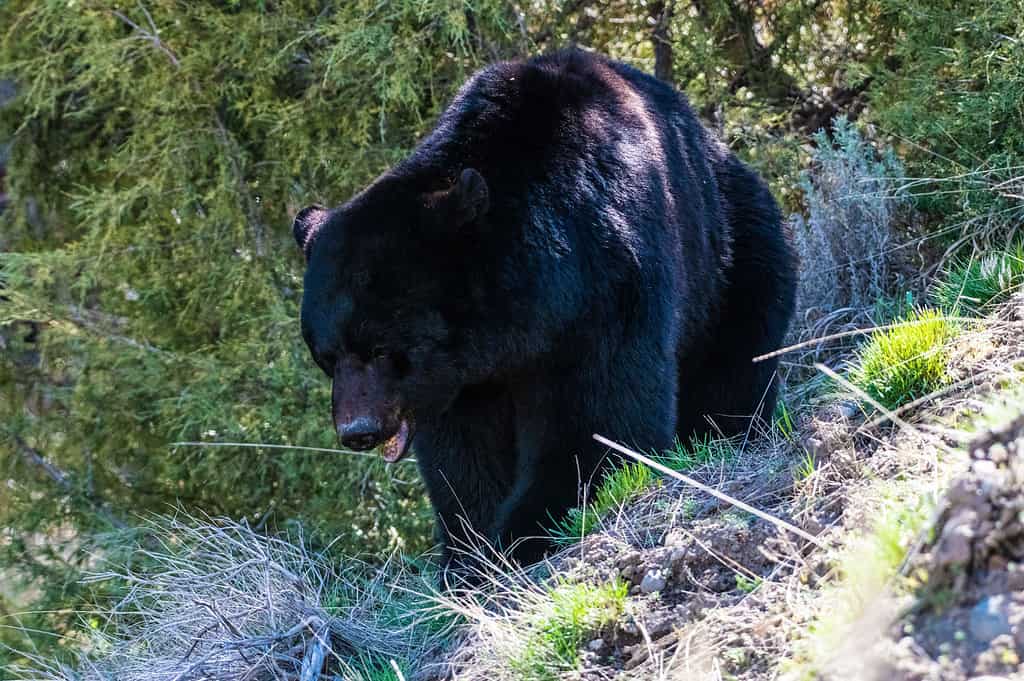
Black bear females weigh between 100 and 250 pounds as adults.
©iStock.com/John Morrison
According to CNR, the counties of Baraga and Ontonagon were the locations for the largest bear harvests in 2019. The population of bears in the Ontonagon area is large. Officials estimate that there is one bear every two miles in this area. The main reason for the high bear population in Ontonagon County is the Porcupine Mountains.
The “Porkies” offer the black bear plenty of places to create dens for their winter sleep and family raising. Within the mountains are 1200 miles of streams teeming with fish and banks lined with trees, bushes, and natural bear treats.
Porcupine Mountain Wilderness State Park is teeming with black bears. Hikers, campers, and anyone enjoying outdoor activities stand a good chance of running into a bear or two. The area has 60,000 acres of virgin forest and is the highest point in Michigan.
South Haven In The Lower Peninsula
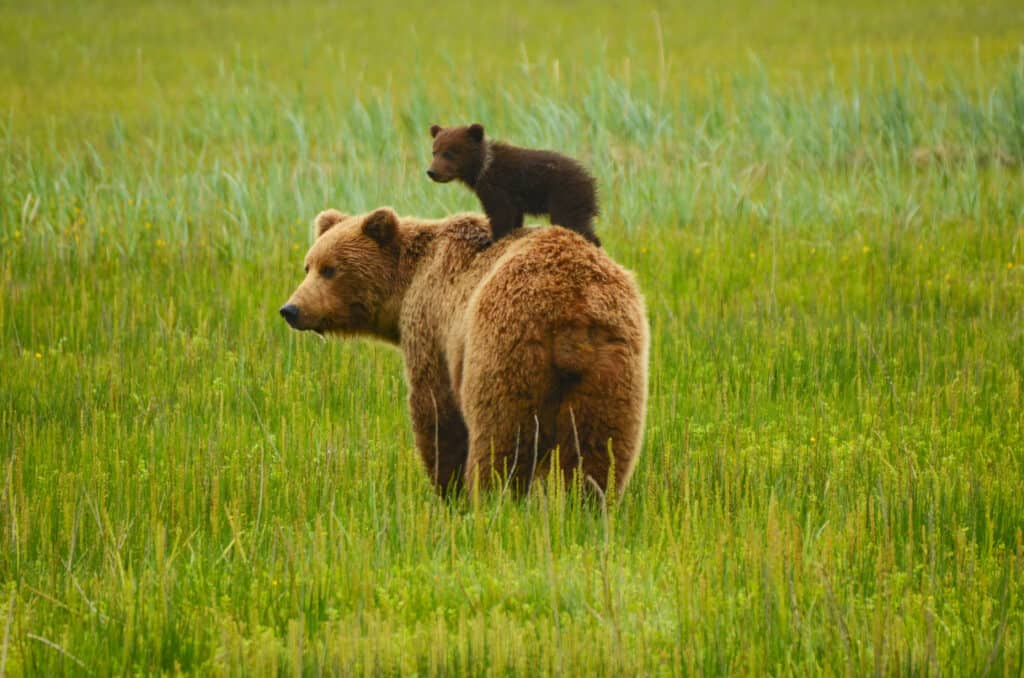
A black bear on all fours measures three feet at the shoulder.
©David Rasmus/Shutterstock.com
Not all “black bears” are black. Black is the standard color of bears in Michigan. However, brown and cinnamon-colored black bears are in this state. Black bears with white fur are rare. South Haven is located on the lower peninsula, where the most significant population increase in black bears has been seen.
South Haven offers 48 miles of land trails and 770 acres in a nature preserve. It is welcoming to outdoor lovers and bears alike. Do not let possible bear sightings stop you from enjoying this delightful part of Michigan. Learn what to do when encountering a bear, how to prevent a bear encounter, and how to get outside to enjoy yourself.
What To Do When You Encounter Bears In Michigan
People who enjoy outdoor activities in Michigan are the most likely to have an encounter with a bear. There are things you can do to prevent a sighting of a bear from becoming a trip to the emergency room.
- Go hiking and participate in activities as a part of a group.
- When walking in the woods, make some noise so the bears know you are coming.
- Do not go hiking at dawn, dusk, or after dark.
- Stay alert, and do not wear headphones while hiking.
- Carry bear spray and learn how to use it properly.
Be Smart Around Black Bears
| S | Stand your ground when you encounter a bear. Do not run. Do not play dead. |
| M | Make loud noises while slowly backing away. |
| A | Always provide an unobstructed escape route for the bear to use. |
| R | Rare encounters with bears result in attacks. Fight back! |
| T | Treat bears respectfully, and keep your distance when you see one. |
Summary Of 7 Spots In Michigan Teeming with Bears
| Location | Portion of Michigan | |
| 1 | Baraga County | Upper peninsula |
| 2 | Upper Peninsula | West Central Michigan |
| 3 | Detroit | Lower Peninsula |
| 4 | Grand Island and The Hiawatha National Park | Upper Peninsula |
| 5 | Ionia County | Lower Peninsula |
| 6 | Ontonagon | Upper Peninsula |
| 7 | South Haven | Lower Peninsula |
The photo featured at the top of this post is © Debbie Steinhausser/Shutterstock.com
Thank you for reading! Have some feedback for us? Contact the AZ Animals editorial team.






